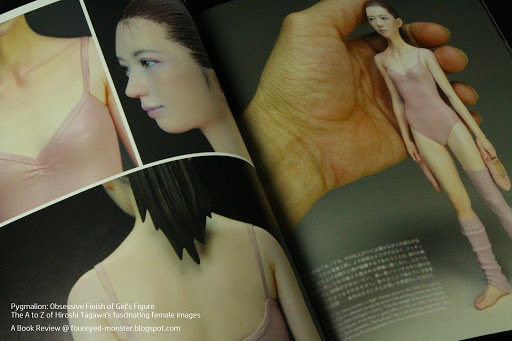Adopting a top down approach to the Bandai Star Wars 1/12 scale Scout Trooper model kit meant I got to work with the most prominent area of the kit first i.e. the Helmet/Head. This kit also comes with the Aratech 74-Z Military Speeder Bike, which makes a great accompaniment to the figurine itself. While the Scout Trooper and Speeder Bike combo is already a huge project by itself, they both are actually part of an even larger project I have in mind. In future Join The Empire/The Empire Needs You vignettes, I plan to pair various soldiers of the Galactic Empire with 1/12 scale female figurines in imaginary propaganda pieces. For now though, let's take look at the Scout Trooper Helmet.
 |
Bandai Star Wars 1/12 scale Scout Trooper Work-in-Progress: Helmet/Head
|
As with all attempts to accurately recreate movie-based figurines, vignettes or dioramas, the output is only as good as its input. And what better reference to use than a book focused solely on the original costumes used in the Star Wars Original Trilogy movies, aptly named Star Wars Costumes (see below). So in terms of color scheme, I have the most accurate reference material possible so there can be no excuses if I mess things up. Well almost, there is always the creative license card to play.
 |
Original Scout Trooper costume as seen here in the book Star Wars Costumes
|
 |
Details of the Scout Trooper Helmet, also sourced from Star Wars Costumes
|
Because Bandai Star Wars model kits are engineered so well, it's extremely easy to breeze through the early stages too quickly and introduce irredeemable mistakes into the project workflow. Minor, silly mistakes are then further compounded down the line, leading to a less than ideal end result. But the thing is, even these so-called substandard finishes still look fairly good, which brings us back to how well engineered these kits are in the first place. In short, I plan to put extra effort into an essentially straightforward build in order to prevent complacency from setting in. Nothing goundbreaking, mind you. Hopefully enough to elevate this kit beyond that of a standard out-of-the-box build.
 |
Pieces of the Scout Trooper Helmet cut off the sprue, and in its unpainted form
|
 |
Initially prior to assembly, only the Comlink Mouthpiece and the Earpieces were painted ...
|
 |
... here the Scout Trooper Helmet is at the sub-assemblies stage ...
|
 |
... and here it has been fully assembled with the minor paint job applied early on
|
 |
Scout Trooper Helmet, fully painted and with its requisite decal applied
|
Although the kit provides water decals for the Scout Trooper Helmet, only one was used i.e. the grey symbol located on the area near the left cheek. Decals to represent the comlink mouthpiece, earpieces, black stripes and circuclar metallic hinges were all ignored and unused because I felt painting these sections would make the Scout Trooper Helmet look far more realistic.
 |
Grey symbol/marking on the left side of the Scout Trooper Helmet is a water decal
|
 |
Black stripes on the forehead and bridge of nose Mr.Weathering Color (Multi Black)
|
 |
Black earpiece and metallic/black comlink mouthpiece were both painted prior to assembly
|
Normally it would be a no-brainer to include weathering on the Scout Trooper so that a higher level of realism can be achieved. But because I intend to include these Galactic Empire soldiers in a 'Join The Army' propaganda vignettes, it wouldn't do to have the Scout Trooper's attire dirtied up and soiled by the Endor Moon environment. Instead, the Scout Trooper (and any other Galactic Empire Soldier for that matter e.g. Stormtrooper, Shoretrooper, etc.) will have on his (or her) pristine attire when posing together with the bevy of young, comely beauties that I'll be painting concurrently.
 |
Located symmetrically on either side of the helmet are circular hinges, which in real-life allows the front of helmet to be swung upwards, were painted a grey metallic color
|
 |
Striped indentations on the lower right section of the helmet were left in their original unpainted to mimic the Scout Trooper Helmet as seen in the movies (see second photo from the top)
|
 |
Back of the Scout Trooper Helmet as painted to mimic how they looked in the movies
|
 |
Indentations on the lower left section of the helmet were panel lined with black weathering paint
|
 |
Grey symbol/marking on the left cheek section was the only decal applied on the helmet
|
Below are photos of the Scout Trooper Helmet arranged so that light doesn't reflect off the eye lens. Apart from that, there isn't any differences between the photos you see below compared to the ones above. On a side note, it's great that Bandai included a reflective lens piece instead of a standard molded piece that you had to paint. Not only does it look better, there is less work involved to boot.
 |
Here, the Scout Trooper Helmet was posed to avoid light reflections on the visor
|
 |
Circular section on the Comlink Mouthpiece is actually black vs. the rest of it which is metallic
|
 |
Most prominent area of the Scout Trooper is now completed, so on to the rest
|
With the most prominent part of the Scout Trooper now complete, it's time to systematically move on to other sections like the torso, arms, legs, etc. It's hard to make a Scout Trooper build exciting, especially if no weathering is involved. Color-wise it's all rather staid with only whites, off-whites, blacks and metallic greys to work with. All I can really do is pay extra attention to little details in the kit and hope it'll make for some interesting work-in-progress posts. Anyway, the weekend is here and it's time to recharge my batteries for the week ahead. Until the next post, stay safe dear readers!





















.jpg)




























